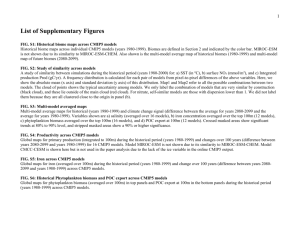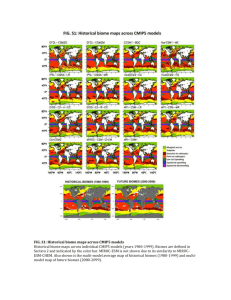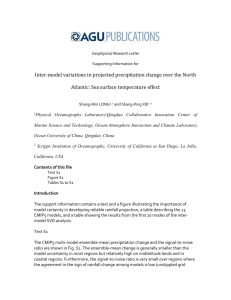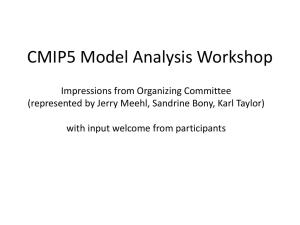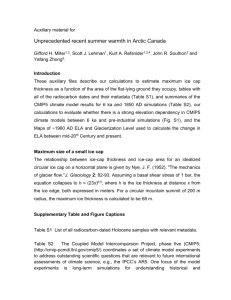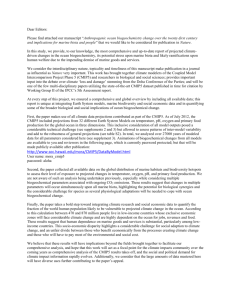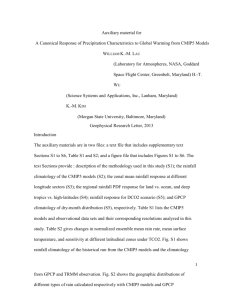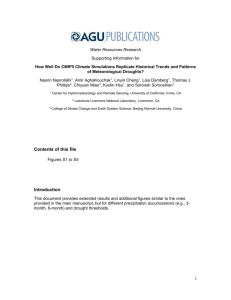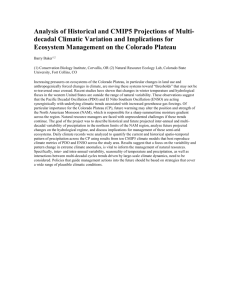grl52843-sup-0001-SupInformation
advertisement
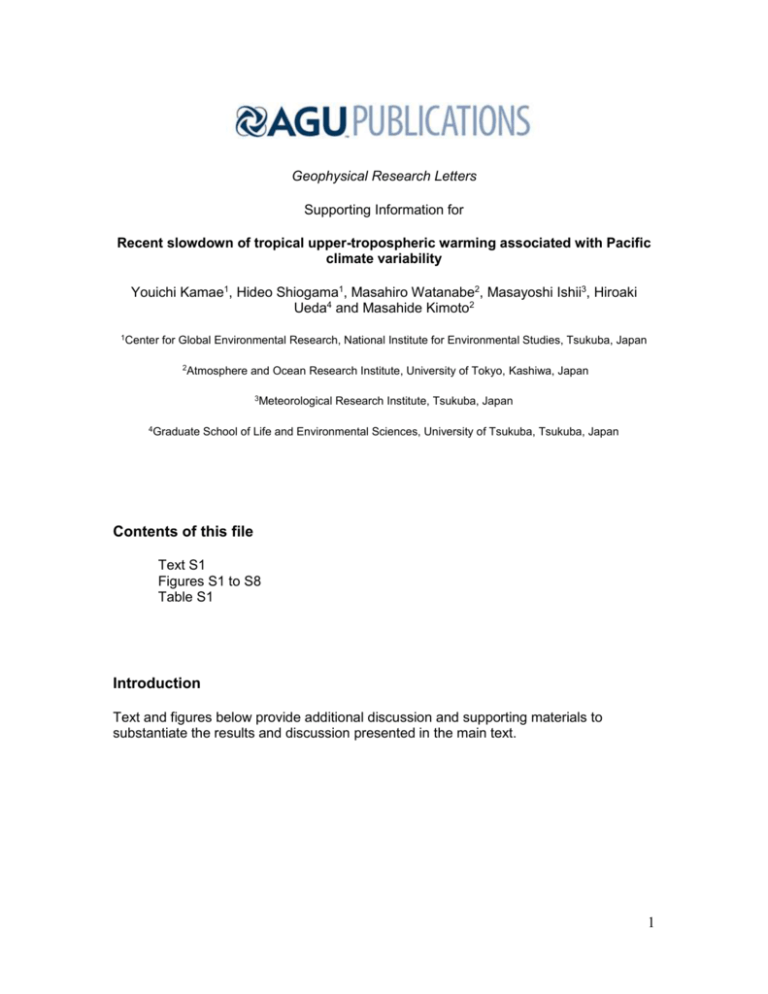
Geophysical Research Letters Supporting Information for Recent slowdown of tropical upper-tropospheric warming associated with Pacific climate variability Youichi Kamae1, Hideo Shiogama1, Masahiro Watanabe2, Masayoshi Ishii3, Hiroaki Ueda4 and Masahide Kimoto2 1Center for Global Environmental Research, National Institute for Environmental Studies, Tsukuba, Japan 2Atmosphere and Ocean Research Institute, University of Tokyo, Kashiwa, Japan 3Meteorological 4Graduate Research Institute, Tsukuba, Japan School of Life and Environmental Sciences, University of Tsukuba, Tsukuba, Japan Contents of this file Text S1 Figures S1 to S8 Table S1 Introduction Text and figures below provide additional discussion and supporting materials to substantiate the results and discussion presented in the main text. 1 Text S1. Upper tropospheric temperature variations in the other dataset To examine upper-tropospheric radiosonde temperature, we used three datasets (RAOBCORE, RICH obs, and RICH τ) in this study (Section 2.1). Upper-tropospheric temperatures are also provided as other datasets. Hadley Centre provides atmospheric temperature dataset HadAT2 [Thorne et al., 2005] ranging from 1958 to the present with a spatial resolution of 5° latitude and 10° longitude. HadAT2 employed a neighborcomposite-based identification of breakpoint. More details of locations of stations, breakpoint identification and adjustment were provided in Thorne et al. [2005]. We only used the grids within the RICH-based mask (Figure S1) to compare the uppertropospheric temperature with the three datasets used in this paper. We also compared ERA-Interim [Dee et al., 2011] with the radiosonde-based upper-tropospheric temperature. As for the MSU/AMSU-based estimate of the upper-tropospheric temperature (T24), we showed a spatial pattern of T24 derived from NOAA/STAR [Zou et al., 2006, 2009] in Figure 2e. We also examined other MSU datasets provided by the University of Alabama in Huntsville (UAH version 5.6; Christy et al., 2003) and the Remote Sensing System (RSS version 3.3; Mears and Wentz, 2009). Figure S2 compares four radiosonde and ERA-Interim TTUT. All the data are anomalies relative to 1968–1990 averages. For ERA-Interim, temperature anomaly TE* is calculated as follows: ̅̅̅̅̅̅̅̅̅̅̅̅̅̅̅ ̅̅̅̅̅̅̅̅̅̅̅̅̅̅̅ 𝑇𝐸 ∗ = 𝑇𝐸 − ̅̅̅̅̅̅̅̅̅̅̅̅̅̅̅ 𝑇𝐸1979−1990 + 𝑇𝑅 1979−1990 − 𝑇𝑅1968−1990 (1) TE is ERA-Interim temperature, TR is RAOBCORE 1.5 temperature, and bars represent averages for the given periods. All the temperature anomalies shown in Figure S2 are 𝑇 − ̅̅̅̅̅̅̅̅̅̅̅̅̅ 𝑇1968−1990, but TE* for ERA-Interim. All the temperatures show good agreement in the interannual variabilities and long-term trends. Figure S3 shows long-term (1968– 2011) and short-term (1997–2011) TTUT trends. All the radiosonde-based TTUT have comparable long-term (ensemble-means of RICH obs and RICH τ are 0.245 and 0.239 K decade-1, and RAOBCORE 1.5 and HadAT2 are 0.184 and 0.172 K decade-1, respectively) and short-term trends (0.162, 0.128, 0.121, 0.130 K decade-1 for RICH obs, RICH τ, RAOBCORE 1.5 and HadAT2, respectively). However, some differences among the datasets are also found. For example, long-term trend in HadAT2 and short-term trend in ERA-Interim (0.071 K decade-1) show smaller trends than the others, respectively. A relatively smaller long-term trend in HadAT2 than the others was detailed in Thorne et al. [2011]. Some assessments based on realistic validation experiments suggested that HadAT likely exhibits too little tropospheric warming over the satellite era over the tropics [McCarthy et al., 2008; Titchner et al., 2009]. Figure S5 shows TTUT anomaly averaged over the CP grids (black boxes in Figures 2, 3, S4 and S8) in four radiosonde datasets compared with HadISST anomaly averaged over the Nino3.4 region. All the CP TTUT from four datasets show slight cooling (RAOBCORE 1.5 and RICH τ) or muted change (RICH obs and HadAT2) during the recent decades (Figures 2c and S5) despite the tropical-mean warming (Figures S2 and 2 S3). As for the interannual variability, CP TTUT shows a high correlation with the Nino3.4 SST (Figures S5 and S8). Correlation coefficients of CP TTUT in RAOBCORE 1.5, RICH obs, HadAT2 with the Nino3.4 SST are 0.84, 0.76, 0.67, respectively. We should note that 1) the HadAT2 has a lower correlation with the Nino3.4 SST and 2) the HadAT2 shows warmer condition than the other three temperature data in the recent years. The large uncertainty among the different radiosonde temperature datasets was also noted in previous studies [e.g., Santer et al., 2008; Thorne et al., 2011; Seidel et al., 2012]. In addition to the radiosonde datasets, T24 anomalies derived from three datasets (NOAA, UAH and RSS) also show some differences among them. For example, amplitudes of cooling in the subtropical twin CP areas (Figures 2e and S6) are different among the three (maximum cooling in the subtropical CP areas are 0.0, −0.4 and −0.2 K in NOAA/STAR, UAH and RSS, respectively). However, all the datasets show clear zonally-asymmetric T24 anomaly patterns. We can conclude that the recent negative phase of the PDO (Figures 3b and S8) contributes significantly to the recent TTUT (and T24) anomalies. Comparison between the recent TTUT in the observations and CMIP5 multi-model ensemble mean The CMIP5 multi-model mean shows a less frequent variability (Figure 1a) and a larger long-term trend in TTUT than the observation (Figure S3; 0.354 and 0.184 K per decade for 1968–2011 in the CMIP5 multi-model mean and RAOBCORE 1.5, respectively). Because the CMIP5 ensemble was not designed to simulate the observed natural variability of SST, less reproducibility in interannual variability of TTUT was expected (except for the volcanic events). In addition, the internal climate variabilities in the individual realizations are smoothed out, resulting in the less frequent variability when the multi-model realizations are averaged (Figure 1a). Both the observed and the AGCM-simulated short-term changes (2001–2011 minus 1991–2000) in TTUT and T24 show the zonally-asymmetric patterns (Figures 2c, 2d, 2e, 2f, and S6). In contrast, the TTUT and T24 anomalies derived from the CMIP5 multi-model mean (Figures S4b and S4c) show warming throughout the tropics, contributing to the tropical-mean warming bias during this period (Figure 1a). The observation–model gap in CP TTUT (Figures 2c and S4b) associated with the tropical Pacific cooling (Figure 3b) as a part of the natural variability (Figure 3d) is one of the largest contributors to the TTUT gap during the recent years (Figure 1a). We further examined the contribution from the natural SST variability to the TTUT discord between the observation and CMIP5 multi-model mean. Figure S7 shows the time series of TTUT anomaly simulated in CMIP5, and the Nat and Anthro effects estimated from the AGCM runs (Section 2.2). Compared with the CMIP5 multi-model mean, RICH τ shows higher frequency variability associated with ENSO and less warming during these 15 years (Figures 1a, 1c, S1 and S3). Two time series obtained from the difference between the ensemble means of RICH τ and CMIP5 (blue line in Figure S7a) and the Nat effect, estimated by the AGCM runs (blue line in Figure S7b), show similar interannual variations and long-term cooling trends. Because of the large influences of the ENSO in the TTUT time series (Figure S8), the interannual variations of the two show high correlation (R between the two detrended time series is 0.74). In addition, the long-term cooling trend owing to the Nat effect (−0.040 0.006 K decade-1 with 95% confidence interval during 1968–2011) accounts for 37.4 5.6% of that of the “RICH τ minus CMIP5 mean” (−0.107 K decade-1) in contrast to the continuous warming 3 owing to the Anthro effect (0.292 0.011 K decade-1). These results indicate that the CMIP5 multi-model mean cannot reproduce accurately the recent variations and longterm trend of TTUT because of the large influence of tropical Pacific SST (Figures 3b, 4 and S8) on the recent variability in TTUT. Note that volcanic eruptions (before 2005) were implemented as a natural forcing factor (Figure S7b) while this forcing was implemented in the CMIP5 AOGCM runs. As suggested by Haywood et al. [2014] and Santer et al. [2014], recent volcanic forcings have substantial contributions on the decadal-scale tropospheric temperature variations. The relative importance of the internal SST variability on the observed long-term TTUT trend, compared with that of the volcanic forcing, should be further examined by other methodologies. We should also note that the difference in CP TTUT is insufficient to explain all the tropical-wide discrepancy between the CMIP5 multi-model mean and observations (Figures 2 and S4). Natural SST variation (Figure 3d) contributes to tropical-wide cooling in the upper troposphere (Figure 3c) and part of this can be ascribed to tropical-wide free-tropospheric warming/cooling in response to SST perturbations in the tropics [Kamae et al., 2014], often referred to as the “weak temperature gradient” [Sobel et al., 2001]. CMIP5 multi-model ensemble and MIROC5 11-member initial condition ensemble In this study, two AOGCM ensembles are examined: single-member, 25-model ensemble (CMIP5 multi-model ensemble) and 11-member, single model ensemble (MIROC5 11-member ensemble). To quantify the role of internal climate variability in the TTUT variation, we used MIROC5 11-member ensemble. This is because the uncertainty in the CMIP5 multi-model ensemble contains both the internal climate variability and other factors, including different climate sensitivity [Andrews et al., 2012], fast adjustment [Kamae and Watanabe, 2012], and representation of control climate among the different models. In Section 3.2, we used MIROC5 11-member ensemble because these realizations were derived from single AOGCM and the uncertainty can be attributed to the internal climate variability [e.g., Watanabe et al., 2013]. Note that ensemble-mean of MIROC5 shows a smaller long-term increase in TTUT than CMIP5 multi-model mean (Figures 1b and S3). This is consistent with the fact that the MIROC5 has a relatively lower climate sensitivity than the CMIP5 multi-model ensemble mean [Andrews et al., 2012]. References Andrews, T., J. M. Gregory, M. J. Webb, and K. E. Taylor (2012), Forcing, feedbacks and climate sensitivity in CMIP5 coupled atmosphere-ocean climate models, Geophys. Res. Lett., 39, L09712, doi:10.1029/2012GL051607. Christy, J. R., R. W. Spencer, W. B. Norris, W. D. Braswell, and D. E. Parker (2003), Error estimates of version 5.0 of MSU-AMSU bulk atmospheric temperatures, J. Atmos. Oceanic Technol., 20, 613–629, doi: 10.1175/15200426(2003)20<613:EEOVOM>2.0.CO;2. Dee, D. P., et al. (2011), The ERA-Interim reanalysis: Configuration and performance of the data assimilation system, Q. J. R. Meteorol. Soc., 137, 553–597, doi:10.1002/qj.828. 4 Haywood, J. M., A. Jones, and G. S. Jones (2014), The impact of volcanic eruptions in the period 2000-2013 on global mean temperature trends evaluated in the HadGEM2ES climate model, Atmos. Sci. Lett., 15, 92–96, doi:10.1002/asl2.471. Kamae, Y., and M. Watanabe (2012), On the robustness of tropospheric adjustment in CMIP5 models, Geophys. Res. Lett., 39, L23808, doi:10.1029/2012GL054275. Kamae, Y., M. Watanabe, M. Kimoto, and H. Shiogama (2014), Summertime land–sea thermal contrast and atmospheric circulation over East Asia in a warming climate– Part II: Importance of CO2-induced continental warming, Clim. Dyn., 43, 2569–2583, doi:10.1007/s00382-014-2146-0. McCarthy, M. P., H. A. Titchner, P. W. Thorne, S. F. B. Tett, L. Haimberger, and D. E. Parker (2008), Assessing bias and uncertainty in the HadAT-adjusted radiosonde climate record, J. Clim., 21, 817–832. doi:10.1175/2007JCLI1733.1. Mears, C. A., and F. J. Wentz (2009), Construction of the remote sensing systems V3.2 atmospheric temperature records from the MSU and AMSU microwave sounders, J. Atmos. Oceanic Technol., 26, 1040–1056, doi:10.1175/2008JTECHA1176.1. Santer, B. D., et al. (2008), Consistency of modelled and observed temperature trends in the tropical troposphere, Int. J. Climatol., 28, 1703–1722, doi:10.1002/joc.1756. Santer, B. D., et al. (2014), Volcanic contribution to decadal changes in tropospheric temperature, Nat. Geosci., 7, 185–189, doi:10.1038/ngeo2098. Seidel, D. J., M. Free, J. S. Wang (2012), Reexamining the warming in the tropical upper troposphere: Models versus radiosonde observations, Geophys. Res. Lett., 39, L22701, doi:10.1029/2012GL053850. Sobel, A. H., J. Nilsson, and L. M. Polvani (2001), The weak temperature gradient approximation and balanced tropical moisture waves, J. Atmos. Sci., 58, 3650–3665, doi:10.1175/1520-0469(2001)058<3650:TWTGAA>2.0.CO;2. Thorne, P. W., D. E. Parker, S. F. B. Tett, P. D. Jones, M. McCarthy, H. Coleman, and P. Brohan (2005), Revisiting radiosonde upper air temperatures from 1958 to 2002, J. Geophys. Res., 110, D18105, doi:10.1029/2004JD005753. Thorne, P. W., J. R. Lanzante, T. C. Peterson, D. J. Seidel, and K. P. Shine (2011), Tropospheric temperature trends: history of an ongoing controversy, WIREs Climate Change, 2, 66–88, doi:10.1002/wcc.80. Titchner, H. A., P. W. Thorne, M. P. McCarthy, S. F. B. Tett, L. Haimberger, and D. E. Parker (2009), Critically reassessing tropospheric temperature trends from radiosondes using realistic validation experiments, J. Clim., 22, 465–485. doi:10.1175/2008JCLI2419.1. Watanabe, M., Y. Kamae, M. Yoshimori, A. Oka, M. Sato, M. Ishii, T. Mochizuki, and M. Kimoto (2013), Strengthening of ocean heat uptake efficiency associated with the recent climate hiatus, Geophys. Res. Lett., 40, 3175–3179, doi: 10.1002/grl.50541. Zou, C.-Z., M. Goldberg, Z. Cheng, N. Grody, J. Sullivan, C. Cao, and D. Tarpley (2006), Recalibration of microwave sounding unit for climate studies using simultaneous nadir overpasses, J. Geophys. Res., 111, D19114, doi:10.1029/2005JD006798. Zou, C.-Z., M. Gao, and M. Goldberg (2009), Error structure and atmospheric temperature trends in observations from the Microwave sounding Unit, J. Clim., 22, 1661–1681, doi:10.1175/2008JCLI2233.1. 5 Figure S1. CMIP5 25-model mean of zonal-mean temperature anomaly in (a) 1991– 2011 and (b) 2070–2099 relative to 1968–1990. (c) Ensemble means of TTUT anomaly (relative to 1968–1990 mean) in RICH τ (red) and CMIP5 25 models (black line) and its 1 standard deviation (gray shading). TTUT is defined by 200–300 hPa mean temperature averaged over tropical grid points (shaded in black) in 20°S–20°N. The tropical grid points are derived by a criterion that 95% of the data are available during 1981–2000 and 2001–2011 in RICH/RAOBCORE dataset. 6 Figure S2. Similar to Figure 1a, but for comparison of the radiosonde datasets and reanalysis. ERA-Interim (gray), HadAT2 (red), RAOBCORE 1.5 (blue), RICH obs (green), and RICH τ (black). 7 Figure S3. Scatter plot of the linear trends of TTUT (K decade-1) during 1968–2011 (horizontal axis) and 1997–2011 (vertical axis). The linear trends and their uncertainty ranges (lines are minimum-maximum ranges and boxes represent 25–75% ranges) are identical to Figures 1b and 1c, but with HadAT2 and ERA-Interim. Purple horizontal line represents linear trend of ERA-Interim for 1997–2011 (linear trend for 1968–2011 is not available). Gray diagonal line is an 1:1 line. 8 Figure S4. Similar to Figures 2b, d and f, but for CMIP5 25-model mean. 9 Figure S5. Time series of SST anomaly averaged over 170°W–120°W, 5°S–5°N (red) and TTUT in three-grid (black boxes in Figures 2, 3, S4 and S8) mean over CP. HadAT2 (black), RAOBCORE 1.5 (blue), RICH obs (green) and RICH τ (orange). 10 Figure S6. Similar to Figure 2e, but for (a) UAH version 5.6 and (b) RSS version 3.3. 11 Figure S7. (a) Similar to Figure 1a, but for CMIP5 25-model mean (red) and the difference between RICH τ and CMIP5 25-model mean (blue). The difference is calculated by subtracting CMIP5 time series from the ensemble mean of RICH τ. Shading represents 1 standard deviation. (b) Anthro effect (red) and Nat effect (blue; Section 2.2). 12 Figure S8. (a) Correlation coefficient of SST (HadISST) with ensemble-mean of CP three-grid mean TTUT in RICH τ. (b) Similar to Figure S5, but for SST averaged over 170°W–120°W, 5°S–5°N (red) and ensemble-mean of TTUT in three grid points (gray) and their average (black) from RICH τ. 13 Table S1. List of the CMIP5 models used in Figures 1, S1, S3, S4 and S7. Model name Country ACCESS1.0 Australia ACCESS1.3 Australia BCC-CSM1.1 China BNU-ESM China CCSM4 USA CESM1(CAM5) USA CMCC-CM Italy CMCC-CMS Italy CNRM-CM5 France CSIRO-Mk3-6-0 Australia CanESM2 Canada EC-EARTH Europe FGOALS-g2 China FGOALS-s2 China GFDL-CM3 USA GISS-E2-R USA HadGEM2-ES UK INM-CM4 Russia IPSL-CM5A-LR France IPSL-CM5A-MR France MIROC-ESM Japan MIROC5 Japan MPI-ESM-LR Germany MRI-CGCM3 Japan NorESM1-M Norway 14
